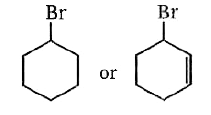Select that pairs in which bond angle of first member is higher than second one.
BrO−3,ClO−3
Asl3,Sbl3
SbBr3,SbI3
NF3,NH3
The correct Answer is:B
To solve the question of which pairs have a higher bond angle in the first member compared to the second member, we need to analyze each pair based on the factors that influence bond angles: the electronegativity of surrounding atoms and the size of the central atom.
1. Understanding Bond Angles:
- Bond angles are influenced by the electronegativity of surrounding atoms and the size of the central atom.
- Higher electronegativity of surrounding atoms leads to smaller bond angles.
- Larger central atoms result in smaller bond angles due to increased repulsion between bonding pairs.
2. Analyzing the First Pair: BrO3- and ClO3-:
- Bromine (Br) is larger than chlorine (Cl).
- Since Br is larger, the bond angle in BrO3- will be smaller than in ClO3-.
- Conclusion: Bond angle of BrO3- < Bond angle of ClO3-.
3. Analyzing the Second Pair: AsI3 and SbI3:
- Arsenic (As) is smaller than antimony (Sb).
- Therefore, the bond angle in AsI3 will be larger than in SbI3.
- Conclusion: Bond angle of AsI3 > Bond angle of SbI3.
4. Analyzing the Third Pair: SbBr3 and SbI3:
- The central atom is the same (Sb), but the surrounding atoms differ (Br and I).
- Bromine is more electronegative than iodine, which means SbBr3 will have a smaller bond angle than SbI3.
- Conclusion: Bond angle of SbBr3 < Bond angle of SbI3.
5. Analyzing the Fourth Pair: NF3 and NH3:
- The central atom is nitrogen (N), but the surrounding atoms differ (F and H).
- Fluorine is more electronegative than hydrogen, leading to a smaller bond angle in NF3 compared to NH3.
- Conclusion: Bond angle of NF3 < Bond angle of NH3.
6. Final Conclusion:
- The only pair where the bond angle of the first member is higher than that of the second member is AsI3 and SbI3.
- Therefore, the correct answer is Option 2.
- Bond angles are influenced by the electronegativity of surrounding atoms and the size of the central atom.
- Higher electronegativity of surrounding atoms leads to smaller bond angles.
- Larger central atoms result in smaller bond angles due to increased repulsion between bonding pairs.
- Bromine (Br) is larger than chlorine (Cl).
- Since Br is larger, the bond angle in BrO3- will be smaller than in ClO3-.
- Conclusion: Bond angle of BrO3- < Bond angle of ClO3-.
- Arsenic (As) is smaller than antimony (Sb).
- Therefore, the bond angle in AsI3 will be larger than in SbI3.
- Conclusion: Bond angle of AsI3 > Bond angle of SbI3.
- The central atom is the same (Sb), but the surrounding atoms differ (Br and I).
- Bromine is more electronegative than iodine, which means SbBr3 will have a smaller bond angle than SbI3.
- Conclusion: Bond angle of SbBr3 < Bond angle of SbI3.
- The central atom is nitrogen (N), but the surrounding atoms differ (F and H).
- Fluorine is more electronegative than hydrogen, leading to a smaller bond angle in NF3 compared to NH3.
- Conclusion: Bond angle of NF3 < Bond angle of NH3.
- The only pair where the bond angle of the first member is higher than that of the second member is AsI3 and SbI3.
- Therefore, the correct answer is Option 2.
Topper's Solved these Questions
Similar Questions
Knowledge Check
Among the given pairs in which pair, first compound has higher boiling point than second ?
ACH3−CH2OCH3andCH3−CH∣OH−CH3BCH3−CH2−CH2−CH3andCH3−CH2−CH3CCH3−CH2−CH2−CH2−CH3andCH3−CH2−CH3∣CH−CH2−OHDCH3−CH2−CH2−CH3andCH3−CH2−CH2−ClAmong the given pairs, in which pair first compound reacts faster than second compound inSN1 reaction ?
ACH3−CH2−CH2−CH2−Br or CH3−CH2-CH∣Br−CH3BCH3−CH3∣C∣CH3−CH2−CH2 or CH3−C∣BrH−CH3∣CH−CH3C DCH3−CH3∣C∣Br−CH3 or CH3−CH3∣C∣I−CH3
DCH3−CH3∣C∣Br−CH3 or CH3−CH3∣C∣I−CH3In which of following pairs the first one is the stronger base than second?
ACH3COOө,HCOOөBөH,өOH,өNH2CCH2=CөH,HC≡өCDCH3NH2,CH3OH
Choose the pair in which IE1 of first element is greater than IE1 of second element but in case of IE2 order is/are reversed
View SolutionIn which case first has lower melting point than second ?
View SolutionIn which pair the first atom or ion is not larger than the second :-
View SolutionWhy is the bond angle of water less than the bond angle of CH4?
View SolutionSome pairs of acids are given below. Select the pair in which second acid is stronger than first
View Solution
